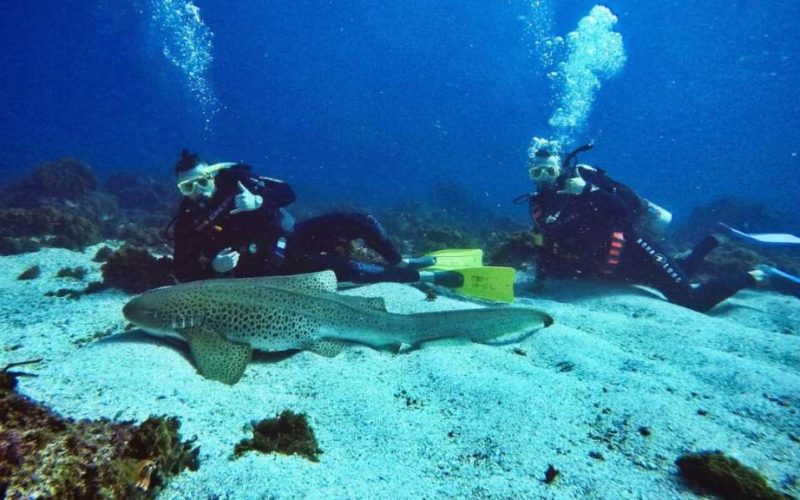February 11, 2025
Welcome to the Jersey Gypsy column, where Valentina, our in-house travel reporter, explores the world in search of tales.
With good cause, the Great Barrier Reef is frequently referred to as one of the most breathtaking natural wonders in the world.
Covering more than 2,300 kilometers (just over 1,400 miles) of Australia’s coastline, it is a haven for marine life, coral gardens, and the real charm that is difficult to discover elsewhere. For many tourists, diving here is the main reason they came in the first place, not just something to do on their bucket list.
Before coming to Australia, I had heard it from a lot of friends and travel guides, anyway.
However, I wasn’t instantly convinced by the idea because I had minimal diving experience and a healthy dose of anxiety about going into open water.
Here is all the information you require for my very first dive!
Picking a Tour Company
The Great Barrier Reef diving experience starts long before you board the boat.
Selecting the appropriate tour operator was the first step for me. I soon realized how important it was to complete my homework because there were so many operators offering trips to the reef.
There were plenty of possibilities, ranging from luxurious live-aboard vacations to inexpensive day outings. Finding the ideal match for your trip requires striking a balance between your desired adventure, your personal experience level, and the departure location. Since this can be a complex process, I advise you to begin your study months in advance.
Deciding Where to Begin
My first instinct was to start in Cairns. It is the Gateway to the Great Barrier Reef, after all. For novices like myself, it provides the most variety, so I had no trouble locating everything from training classes to introductory dives.
I wanted the convenience and variety that Cairns promised, but other places, like Port Douglas or Airlie Beach, are better suited for smaller groups or combined sailing and diving trips.
Comparing Companies & How to Pick Them
The next step was to reduce the number of travel operators. I had to decide whether or not I wanted a boutique diving experience because there were so many possibilities. Or something more affordable and social? There were two notable pro dive providers:
Divers’ DenThis one immediately caught our attention due to its stellar reputation among novices. They provide lots of direction, a strong emphasis on safety, and the opportunity to advance past a single introduction dive.
However, I was enticed by Down Under Cruise and Dive’s sleek catamaran and all-inclusive packages that included helicopter rides over the reef, diving, and snorkeling.
I read the reviews and saw that Divers Den was commended for its understanding teachers and straightforward communication, which helped me ease my beginner’s anxiety. While some reviewers noted that the larger groups sometimes seem impersonal, Down Under received great reviews for its well-planned day tours and aboard experience.
Making My Choice
In the end, I chose Divers Den. Offering a small-group day trip with an emphasis on novice divers seemed like the ideal balance for my situation.
Intimate enough to make the event feel unique but structured enough to feel comfortable. I was able to put my anxieties aside because I knew I would be diving at a famous reef with expert supervision and lots of support.
Mostly, anyway.
The Trip
I started my morning feeling a little anxious and buzzing with excitement.
After giving our small group a brief safety instruction and a warm welcome, the Divers Den crew set the tone for an exciting day of adventure that was kept under control.
As we navigated the calm waters to our first of two dive locations, the other divers around me engaged in animated conversation. Their excitement was infectious despite my nervousness, and I quickly noticed that I was starting to calm down.
Even though I had to check and recheck my equipment several times during the trip, I felt comfortable because of the crew’s professionalism and good humor.
It was impossible to avoid being enthralled once we anchored at the reef.
The turquoise-blue ocean was so vivid that it nearly didn’t seem real. Additionally, I could immediately see schools of fish swimming around the coral formations just below the surface, displaying bursts of color.
Taking the Plunge
My nerves were in full swing when it was time to get ready. It felt weird to have the tank on my back, and I tried really hard not to hum the Jaws theme while I repeatedly used the breathing exercises I had learned in training as a mantra.
I dunnnn dun.
Things were in order before I realized it. Before I could second-guess myself, I pushed myself into the water after the instructor gave me a quick inspection and a nod.
The world below seemed overpowering at first. It was utterly alien and impossible in size. But as we went down, the dread vanished and was replaced with awe. I couldn’t have anticipated how alive the reef was. Schools of fish danced in unison, their scales gleaming like polished gems, and corals erupted in brilliant hues.
It resembled entering a vibrant underwater metropolis.
Between Dives
We went back to the boat to rest after the first dive. The lunch, which consisted of a straightforward sandwich and fresh fruit, was excellent, but I can’t say I appreciated it as much as some of the other meals I had in restaurants around Australia prior to coming here.
While the crew navigated the boat to our secondary location, the group shared anecdotes about what they had witnessed while we were eating.
Have you seen the enormous clam?When someone inquired, I realized that I hadn’t even noticed because I had been so enthralled with the fish. Fortunately, we still had another dive in front of us, and I planned to keep my mind active.
The Second Dive
It felt very different on my second dive. The weight of all the equipment and my breathing—which is more difficult than you might imagine—were no longer my main concerns.
I was completely engrossed in the beauty of the reef this time. I did saw the second enormous clam, which was a huge whirlpool of bright blues and greens, and I even had the opportunity to swim for a little while with a sea turtle.
I was reluctant to leave when it was time to rise. The gorgeous, vibrant life below seemed a planet away from the surface.
Heading Back
I reclined in my seat on the way back. Completely satisfied.
As I mentally relived the day’s highlights, the sunlight warmed my face. Now, the nerves that had previously holding me back felt almost absurd.
Info Guide
The Great Barrier Reef left a lasting impression. It wasn t just the jaw-dropping sights, though I will admit, swimming alongside a sea turtle felt like something out of a nature documentary. Everything about the dive was about stepping out of my comfort zone and finding a whole new world just beneath the surface.
Would I repeat it?Of course. For a first-timer, it was the perfect mix of awe and adventure, with just enough structure to keep me from freaking out.
I m sure I would be more relaxed the next time, allowing me to focus more on the beauty at hand. At least, that s what I ll tell my editors when I beg them to foot the bill for sending me back.
Lessons Learned
As much fun as I had (and as few hiccups as there were), there are a few things I wish I d known beforehand:
Recommendations & Tips
If you re planning your own dive, here is what I d suggest:
Taking the Plunge Something Worth Remembering
Diving the Great Barrier Reef was a whole new and different adventure it was an unforgettable journey into the world I had only seen in pictures before.
Whether you re a seasoned diver or, like me, someone just dipping their toes in the waters, the Great Barrier Reef offers something extraordinary, so if you are still not sure, my recommendation is to try it.
Diving the Great Barrier Reef FAQs
What is the Best Month to Dive the Great Barrier Reef?
The reef is a great year-round destination, but your experience might vary depending on the season. For clear water and calm seas, June to October (the Aussie winter) is best.
This is also a stinger-free season, so you won t have to worry about jellyfish. That said, November to May brings warmer water and lush coral spawning events if you re willing to take extra precautions like wearing stinger suits.
I went at the end of October, and it was fantastic. Check with your tour operator for the latest conditions.
Can Beginners Dive the Great Barrier Reef?
Of course!
I m proof that you don t need to be a seasoned diver to enjoy this incredible experience. Many operators offer special introductory dives for first-timers, and some even include basic training on the boat before you hit the water.
If you re nervous, let the crew know they re experts at making beginners feel comfortable and confident. Plus, having a guide by your side ensures a safe and unforgettable adventure.
Do I Need a Certification to Dive the Great Barrier Reef?
Not necessarily. Many operators cater to beginners with introductory dive packages that do not require prior certification. These dives are supervised by professionals and typically include a safety briefing and basic instruction.
However, if you are dive-certified, you ll have access to deeper and more advanced sites, so it s worth getting your certification if you have the chance.
How Much Does it Cost to Go to the Great Barrier Reef?
Prices can vary depending on the sort of experience you choose. For day trips, expect to pay between $150-300 AUD for a single dive or snorkeling package.
This generally includes gear, lunch, and transport.
If you re looking for a multi-day liveaboard trip, prices can range from $500 to $2,000. It s worth doing your homework to find the right balance between budget and adventure. I found my trip with Divers Den well worth every penny for the personalized experience.
Can I Combine Diving with Other Activities, Like Snorkeling or Sailing?
Yes! Many tours offer multi-activity packages, especially if you re traveling with a group that has mixed interests.
My trip was focused on diving, but some operators also offer sailing trips or scenic helicopter rides. The reef is such a diverse environment with so many things to see that you can easily tailor your experience to pack in as much (or as little) as you want.
Is it Okay to Collect Dead Coral or Shells When Diving?
No, it is not okay to collectanythingfrom the reef.
The reef is a protected UNESCO World Heritage Site, and removing coral, shells, or marine life is both harmful to the ecosystem and illegal. Instead, bring a waterproof camera or just soak in the beauty.
You ll leave with memories far better than any souvenir.






